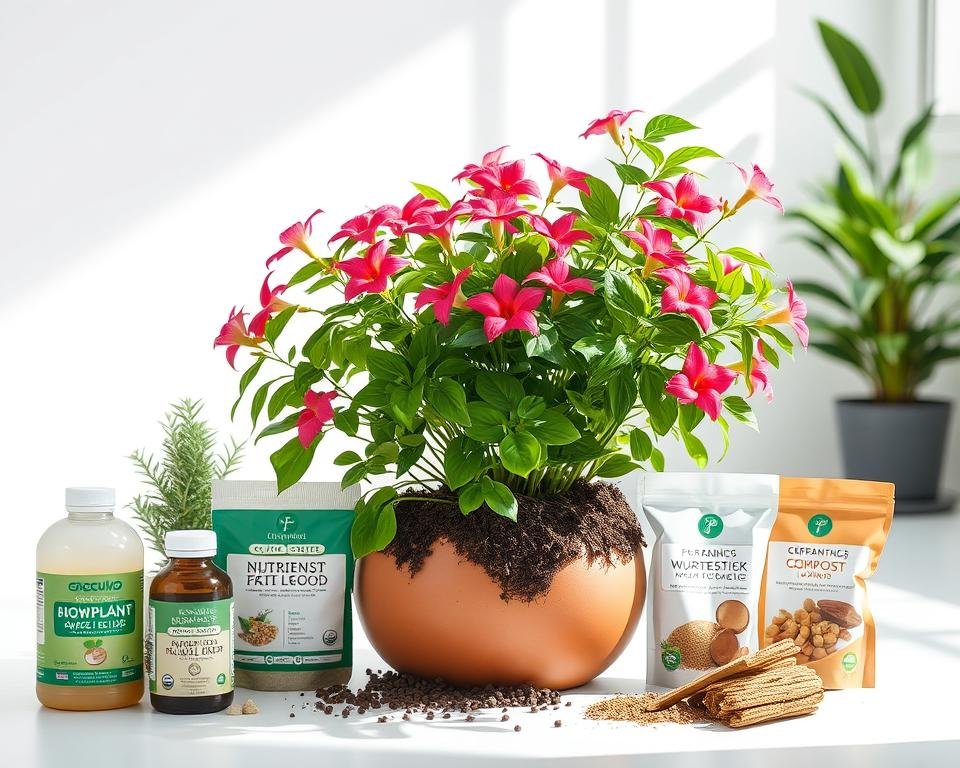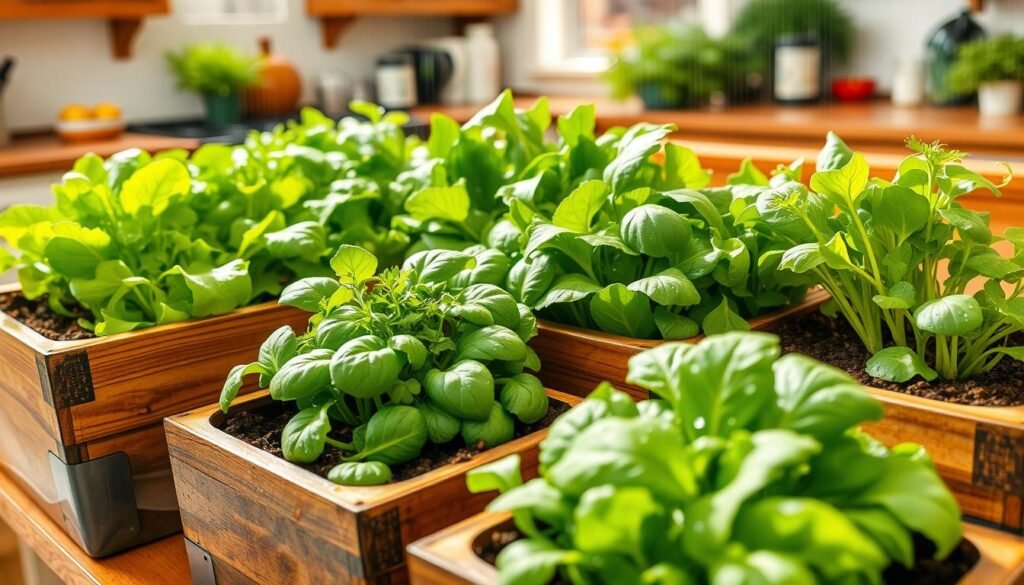Imagine walking through your own personal oasis, picking fresh, nutritious produce right from your backyard. Ever thought about turning that empty space into a vibrant edible garden? This detailed guide will lead you through the steps to start an edible garden from the beginning. It doesn’t matter if you have a big backyard or a tiny patio. You’ll discover how to plan, prepare, and plant a lush garden full of vegetables, herbs, and fruits in your own home.
This beginner’s guide will cover everything from picking the best spot to choosing the right plants. You’ll learn how to grow your own food, use organic gardening methods, and enjoy the tastes of a small space or raised bed garden. Let’s explore the secrets to creating your dream container garden from scratch!
Choosing the Right Location for Your Edible Garden
Choosing the perfect spot for your edible garden is key to success. Whether you’re into garden planning, small space gardening, container gardening, or raised bed gardening, knowing your crops’ needs is vital. This knowledge ensures they grow well and stay healthy.
Sunlight Requirements
Plants vary in their sunlight needs. Some love full sun, while others do better in partial shade. It’s important to check the sunlight in your garden area during the day. This way, you can make sure your plants get the right amount of light.
This step helps you decide which crops to place where. It’s a crucial part of planning your garden.
Soil Quality and Drainage
Good soil is the base of a successful edible garden. Check the soil in your chosen spot. Look at its pH levels, nutrient content, and how well it drains. If needed, add organic matter or other additives to improve it.
Also, make sure the soil drains well. This prevents waterlogging and root rot, which can harm your plants.
| Crop | Sunlight Requirement | Soil Preference |
|---|---|---|
| Tomatoes | Full sun | Well-draining, nutrient-rich |
| Leafy greens | Partial shade | Moist, fertile |
| Carrots | Full sun | Sandy, well-draining |
Planning Your Edible Garden Layout
For beginners in vegetable gardening, planning your garden layout is key. Arranging crops wisely maximizes space, boosts productivity, and fosters a balanced ecosystem. This approach ensures your garden thrives.
Deciding What to Grow
First, choose the vegetables, herbs, and fruits you wish to cultivate. Consider your climate, sunlight, and personal taste. Each plant has unique needs, like sunlight, soil pH, and spacing.
Companion Planting Strategies
Companion planting is a cornerstone of organic gardening. It pairs plants to repel pests, improve soil, and boost growth. Use guides to find the best plant combinations.
| Crop | Companion Plants | Benefits |
|---|---|---|
| Tomatoes | Basil, Marigolds, Chives | Repel pests, improve flavor, enhance growth |
| Carrots | Radishes, Rosemary, Chives | Loosen soil, deter pests, improve flavor |
| Lettuce | Carrots, Radishes, Spinach | Provide shade, deter pests, enhance growth |
With thoughtful garden planning and companion planting, you can build a vibrant, productive edible garden. This way, you can grow your own food sustainably and organically.
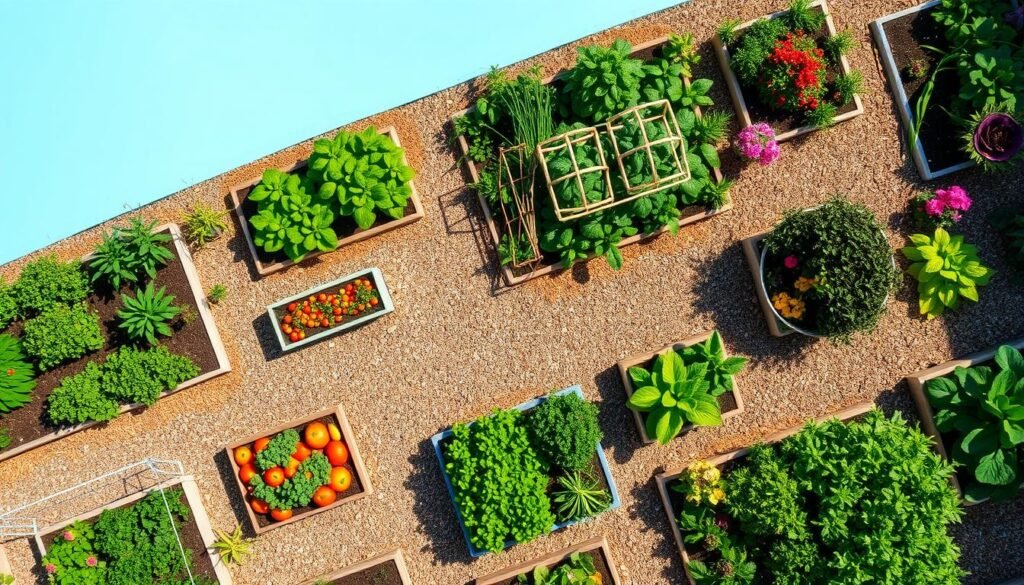
How to Start an Edible Garden from Scratch: A beginner’s guide to planning and
Starting your own edible garden is a rewarding journey, offering fresh, homegrown produce from your backyard. This guide is for both seasoned gardeners and novices, covering the key steps to plan and grow a successful vegetable garden.
Choosing the right location for your garden is crucial. It should get 6-8 hours of direct sunlight daily and have well-draining soil. If your soil lacks quality, adding organic matter like compost can improve it.
Planning your garden layout is the next step. Decide on the vegetables and herbs you want to grow, considering their needs and growth habits. Companion planting can help, pairing plants to use space efficiently and ward off pests.
For starting your garden, high-quality seeds or seedlings are essential. Choose varieties that match your local climate and growing season. Using raised beds or container gardens can also boost your garden’s success.
By following these steps, you’ll be on your way to a thriving edible garden. Enjoy the journey of vegetable gardening and look forward to a bountiful harvest from your own garden.
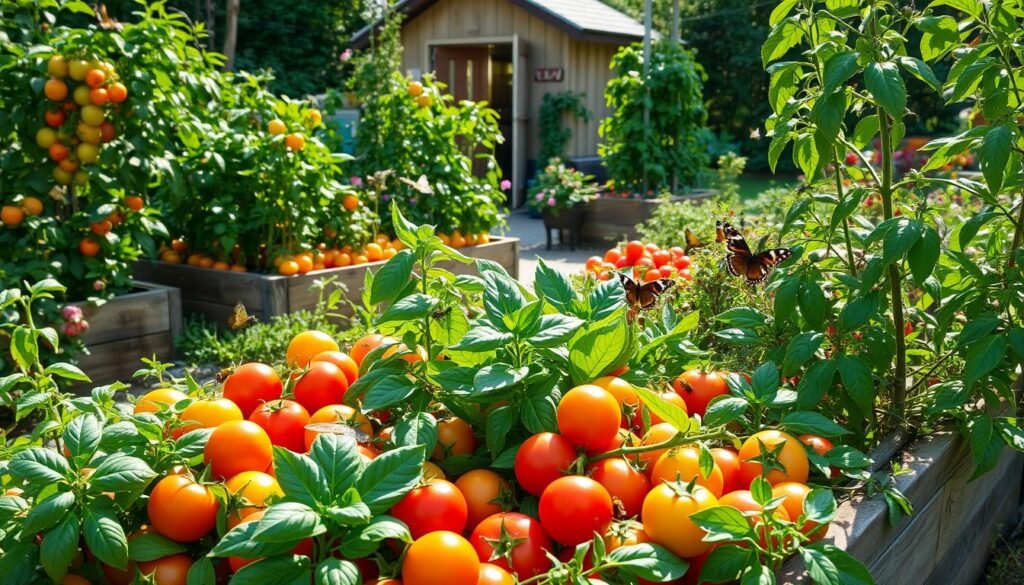
Preparing the Soil and Planting
Starting a thriving edible garden requires proper soil preparation. First, test your soil’s pH level and adjust it if needed. Aim for a pH between 6.0 and 7.0 for best nutrient absorption by your plants.
To enhance the soil, add organic matter like compost or well-rotted manure. This improves soil structure and drainage, and provides vital nutrients. If space is limited, consider using raised beds or containers for your garden.
Planting Techniques
With your soil prepared, it’s time to plant. For in-ground gardens, create shallow holes and gently place seeds or seedlings. Space them as recommended for each plant. For raised beds and containers, ensure the depth and spacing meet the crop’s needs.
- Water the soil well after planting to establish roots.
- Mulch around plants to retain moisture and control weeds.
- Keep an eye on soil moisture and water as needed to maintain consistent moisture.
Proper soil preparation and strategic planting techniques will lead to a bountiful edible garden. Enjoy the fruits of your labor with these organic gardening tips.
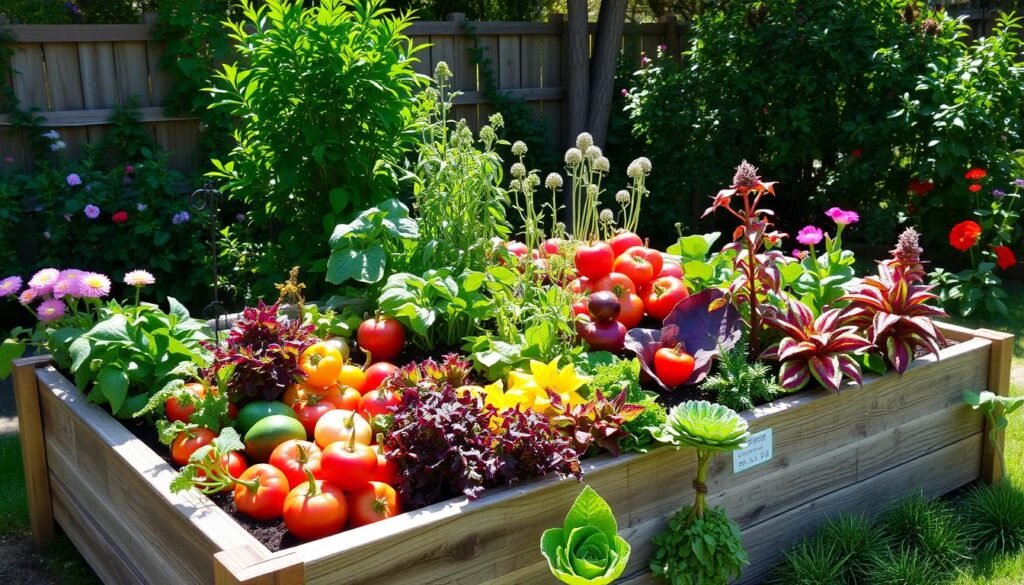
Conclusion
Starting an edible garden from scratch is a rewarding journey. This guide has equipped you with the knowledge to create a vibrant garden at home. Enjoy the fresh produce and the pride of growing your own food.
This how to start an edible garden from scratch: a beginner’s guide to planning and has covered all the basics. From choosing the right spot to preparing the soil, you’re ready to bring your edible gardening dreams to life. Start enjoying the fruits of your labor in your own backyard.
The path to edible gardening is one of discovery and growth. Be open to learning and celebrate your successes. The joy of harvesting your own food is unmatched. Happy gardening!
FAQ
What are the essential factors to consider when choosing a location for an edible garden?
When selecting a spot for your edible garden, focus on sunlight, soil quality, and drainage. Ensure the area gets at least 6 hours of direct sunlight daily. Also, check the soil’s composition to guarantee it’s rich in nutrients and drains well.
How do I decide what to grow in my edible garden?
Deciding what to grow involves considering your preferences, local growing conditions, and garden space. Research the specific needs of various vegetables, herbs, and fruits to ensure they’ll thrive. Think about using companion planting to create a harmonious and productive garden.
What are the essential steps for starting an edible garden from scratch?
Starting an edible garden requires several key steps. First, prepare the soil by testing its pH and adding organic matter. Next, choose high-quality seeds or seedlings. Finally, plant and space your crops correctly. Consider using raised beds or containers for a smaller garden.
How do I maintain the health and productivity of my edible garden?
To keep your garden healthy and productive, water plants regularly and use organic fertilizers. Practice effective weed and pest control. Monitor your plants for disease or stress signs and address issues promptly for a successful harvest.
What are the benefits of growing my own edible garden?
Growing your own edible garden brings many benefits. You gain access to fresh, nutritious produce and control over growing methods. It also allows you to avoid harmful chemicals. Plus, it’s a rewarding hobby that connects you to nature and can be calming.
